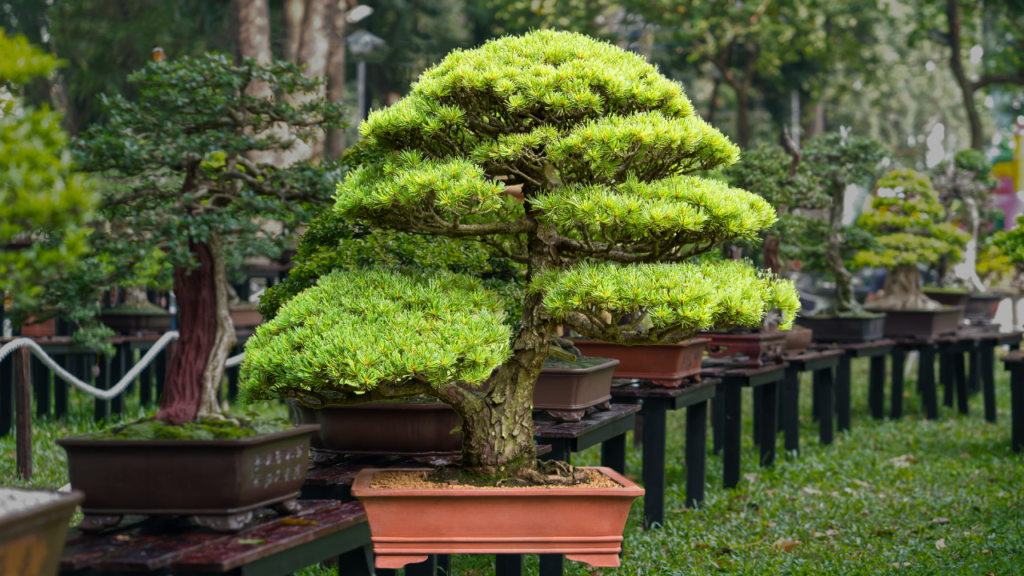Pines are iconic in the world of bonsai, symbolizing endurance, longevity, and strength. Their evergreen nature, combined with their majestic appearance, makes them a sought-after choice for many bonsai enthusiasts. Here’s a comprehensive care guide tailored for Pine bonsai:
| Pine Bonsai Quick Reference | |
|---|---|
| Attribute | Information |
| 🌾Plant Type | Evergreen coniferous tree |
| 📏Mature Size | Varies depending on species and cultivation; typically much smaller when cultivated as bonsai |
| ☀️Sun Exposure | Full sun to partial shade |
| ✂️Pruning | Prune during the growing season; however, light pruning can be done throughout the year to maintain shape |
| 🎭Common Bonsai Styles | Formal upright (Chokkan), Slanting (Shakan), Informal upright (Moyogi), Forest (Yose-ue), Bonsai-on-rock (Ishizuke) |
| 🌲Common Species Used | Japanese White Pine, Pinus Thunbergii (Japanese Black Pine), Scots Pine, Mugo Pine, etc. |
| 🌼Bloom Time | Varies by species |
| 🎨Cone Color | Varies by species |
| ❄️Hardiness Zones | Varies by species |
| 🌎Native Area | Varies by species |
1. Positioning and Light:
- Sunlight: Pines thrive in full sunlight and need several hours of direct sunlight daily to maintain their health and vigor.
- Outdoor Living: Pines are best suited for outdoor living, benefiting from natural light, seasonal changes, and fresh air. They should be protected from extreme wind and intense midday heat.
2. Watering:
- Frequency: Pines prefer a ‘drier’ approach compared to other bonsai species. Water when the top layer of soil begins to dry out, ensuring the soil never becomes waterlogged.
- Method: Water thoroughly, allowing excess water to drain from the pot. Ensure the pot has good drainage to prevent root rot.
3. Soil and Fertilizing:
- Soil: A well-draining soil mix is essential. A blend of akadama, pumice, and a small amount of organic material is ideal.
- Fertilizing: Feed your Pine bonsai with a balanced, slow-release fertilizer during the growing season (spring to early autumn). In the first year after repotting, avoid using nitrogen-rich fertilizers.
4. Pruning and Shaping:
- Pruning: Pines require regular pruning to maintain their shape. Remove any unwanted or weak branches, especially those growing downwards or inwards.
- Wiring: Pines respond well to wiring, but their branches can be brittle. It’s best to wire during the growing season when the branches are more flexible. Always monitor to ensure the wire doesn’t cut into the bark.
5. Needle Plucking:
- To encourage back budding and maintain the tree’s shape, older needles can be plucked in the autumn. This also allows more light and air to reach the inner branches.
6. Repotting:
- Pine bonsai should be repotted every 2-5 years, depending on the tree’s age and the size of the pot. Early spring, just before the new growth starts, is the best time.
- When repotting, be gentle with the roots and remove only the outer layer of soil and roots.
7. Pests and Diseases:
- Pines can be susceptible to pests like pine sawfly, aphids, and red spider mites. They can also face fungal diseases like needle cast. Regular inspections and early interventions are key.
8. Winter Care:
- Most Pine species are cold-hardy but should be protected from extreme cold, especially when young. Consider mulching around the base or placing them in a cold frame during harsh winter months.
9. Recognizing Pine Bonsai Features:
- Pines are recognized by their long, slender needles that grow in clusters and their distinctive, often rough bark. They also produce cones, adding to their aesthetic appeal.
Bonsai Care Essentials
Conclusion:
Pine bonsai trees are a reflection of nature’s grandeur and resilience. Their timeless beauty and symbolic significance make them a cherished choice in the bonsai world. With dedicated care and a deep appreciation for their unique characteristics, your Pine bonsai will stand as a testament to nature’s enduring spirit.
